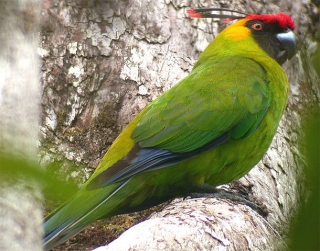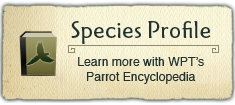Project Regions:
Horned Parakeet |
|
|
Collaborators/Funders
Marc Boussekey, Birdpark of Villars-les-Dombes France, Sophie Rouys, Eric Bureau, Cathy Pelsy, Jean-Marc Lernould and Jorn Theuerkauf
Island parakeet threatened by human activites
The Horned Parakeet, Eunymphicus cornutus, is at risk from habitat degradation and introduced mammals and disease.
Project progress: In 2002 WPT funded the start of a long-term study to map the distribution and abundance of the Horned Parakeet.
Outcomes: Studies and surveys continue in a long-term effort to protect the species, which is fully protected by New Caledonian law. There appear to be robust populations in Rivière Bleue and Reserve Speciale de Faune et de Flore de la Nodela (Ekstrom et al. 2000). Further actions proposed include monitoring possible trade, researching breeding biology and controlling introduced predators. It has also been suggested to enlarge the area of suitable habitat that has been protected and establish captive-breeding populations for future reintroductions.
World population: 7934-9445
Where found: New Caledonia, Melanesia
History: Eunymphicus cornutus, or Horned Parakeet, is endemic to New Caledonia. Its numbers have reduced since the 1880s. On Mt Panié where it is found its range is much reduced; it is now restricted to the north-western part of the Panié massif [Ekstrom et al. 2000, J. Theuerkauf in litt. 2012]). By 2003-2006 there were population estimates of 1,000-3,000 birds (Ekstrom et al. 2000) which included 720 pairs (N. Barré in litt. 1999). A recent study indicates that the species has a wider distribution and is more common than previously thought, a possible population of 8000 - 9000 (Legault et al. in press).
Threats:
- Habitat degradation, through logging and by introduced Rusa deer Rusa timorensis
- Predation by black rats
- Particularly wet years reduce breeding success
- Possible threat from Psittacine Beak and Feather Disease (PBFD)
Ecology: The Horned Parakeet is found mainly above 450m (1476 ft) in humid indigenous forests, secondary growth and savanna woodland. They also occurs in mixed Araucaria forest. Birds feeds on flowers, nuts, fruits, berries, seeds of trees and shrubs, and ripe pawpaw. They are wary and mostly unapproachable, and are generally seen in pairs and small groups of up to 10 birds. Birds roost in the treetops or in tree hollows, becoming active an hour before sunrise.


































